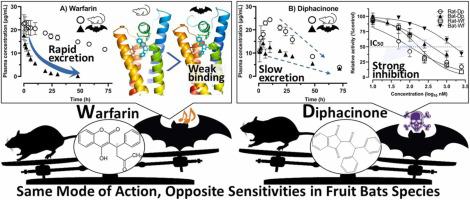Ecotoxicology and Environmental Safety ( IF 6.2 ) Pub Date : 2022-08-15 , DOI: 10.1016/j.ecoenv.2022.113971 Kazuki Takeda 1 , Kosuke Manago 2 , Ayuko Morita 2 , Yusuke K Kawai 3 , Nobuaki Yasuo 4 , Masakazu Sekijima 4 , Yoshinori Ikenaka 5 , Takuma Hashimoto 6 , Ryuichi Minato 6 , Yusuke Oyamada 6 , Kazuo Horikoshi 7 , Hajime Suzuki 7 , Mayumi Ishizuka 2 , Shouta M M Nakayama 8

|
Anticoagulant rodenticides have been widely used to eliminate wild rodents, which as invasive species on remote islands can disturb ecosystems. Since rodenticides can cause wildlife poisoning, it is necessary to evaluate the sensitivity of local mammals and birds to the poisons to ensure the rodenticides are used effectively. The Bonin Islands are an archipelago located 1000 km southeast of the Japanese mainland and are famous for the unique ecosystems. Here the first-generation anticoagulant rodenticide diphacinone has been used against introduced black rats (Rattus rattus). The only land mammal native to the archipelago is the Bonin fruit bat (Pteropus pselaphon), but little is known regarding its sensitivity to rodenticides. In this study, the Egyptian fruit bats (Rousettus aegyptiacus) was used as a model animal for in vivo pharmacokinetics and pharmacodynamics analysis and in vitro enzyme kinetics using their hepatic microsomal fractions. The structure of vitamin K epoxide reductase (VKORC1), the target protein of the rodenticide in the Bonin fruit bat, was predicted from its genome and its binding affinity to rodenticides was evaluated. The Egyptian fruit bats excreted diphacinone slowly and showed similar sensitivity to rats. In contrast, they excreted warfarin, another first-generation rodenticide, faster than rats and recovered from the toxic effect faster. An in silico binding study also indicated that the VKORC1 of fruit bats is relatively tolerant to warfarin, but binds strongly to diphacinone. These results suggest that even chemicals with the same mode of action display different sensitivities in different species: fruit bat species are relatively resistant to warfarin, but vulnerable to diphacinone.
中文翻译:

埃及果蝠 (Rousettus aegyptiacus) 中抗凝血灭鼠剂华法林和敌鼠松的毒代动力学分析作为对 Bonin 果蝠 (Pteropus pselaphon) 的敏感性比较评估
抗凝血灭鼠剂已被广泛用于消灭野生啮齿动物,因为它们作为偏远岛屿的入侵物种会扰乱生态系统。由于灭鼠剂会导致野生动物中毒,因此有必要评估当地哺乳动物和鸟类对毒药的敏感性,以确保有效使用灭鼠剂。博宁群岛位于日本本土东南 1000 公里处,以独特的生态系统而闻名。在这里,第一代抗凝灭鼠剂敌鼠松已被用于对付引入的黑鼠(Rattus rattus)。该群岛唯一的陆地哺乳动物是波宁果蝠(Pteropus pselaphon),但对其对灭鼠剂的敏感性知之甚少。在这项研究中,埃及果蝠 (Rousettus aegyptiacus ) 用作模型动物,用于体内药代动力学和药效学分析以及使用其肝微粒体部分的体外酶动力学。维生素 K 环氧化物还原酶 (VKORC1) 是 Bonin 果蝠中杀鼠剂的靶蛋白,从其基因组预测其结构,并评估了其与杀鼠剂的结合亲和力。埃及果蝠的排泄很慢,对老鼠也表现出相似的敏感性。相比之下,他们排出另一种第一代灭鼠剂华法林的速度比老鼠快,而且从毒性作用中恢复得更快。计算机_结合研究还表明,果蝠的 VKORC1 对华法林具有相对耐受性,但与敌烟酮结合力较强。这些结果表明,即使是具有相同作用方式的化学物质,在不同物种中也表现出不同的敏感性:果蝠物种对华法林具有相对抗性,但易受敌菌酮的影响。


















































 京公网安备 11010802027423号
京公网安备 11010802027423号